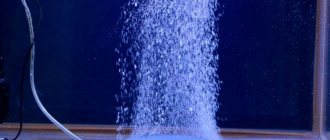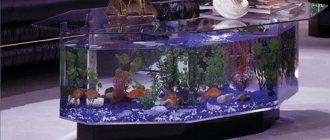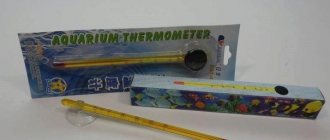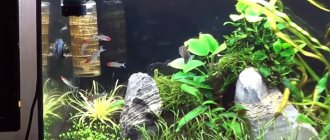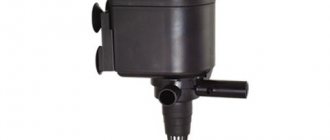When starting their first artificial pond, novice fish keepers are wondering whether a compressor is needed in an aquarium, and whether it is possible to do without this device. You can answer this question by understanding what an aquarium compressor is and how it works. Keeping fish in home containers requires an environment saturated with oxygen - exactly what a compressor is needed for, because this device is designed to fill the liquid with oxygen. There are different types of compressors, so before choosing the best model, you should familiarize yourself with the characteristics and detailed description of the design.
What is the need for a compressor?
Before you purchase any equipment for supplying oxygen to an aquarium, you should understand why the device is needed and how it works. The main principle by which experienced pond owners are guided is the safety and comfort of small inhabitants, therefore the purchase of any device should be made in the interests of fish, plants and shellfish.
As you know, the life of the inhabitants of the underwater depths without air is unthinkable, so the aquarium liquid must contain oxygen. The compressor in the aquarium copes with this task perfectly, filling the water with oxygen, which is the answer to the question: why do you need a compressor in the aquarium?
Of course, if there is a large amount of underwater flora, some aquarists may have doubts about the need for the device. After all, plants are also known for enriching the aquatic environment with oxygen, but this volume is not enough for fish to fully develop. In addition, many strange species of fish are capricious about this issue, and if there is a lack of oxygen, they get sick or die.
In addition to supplying air, compressors in aquariums create oxygen flows - aeration, which mixes the layers, preventing the liquid from dying out. Otherwise, an unpleasant film will form in a reservoir with an unshakable water mass, which will definitely ruin the appearance.
Exploitation
This device belongs to the category of bought and for a long time. But in order for the device to serve for a long time, it is necessary to properly monitor it:
- Cooling. Only a correctly installed device will not overheat. If the temperature is higher than the permitted norm, it should be taken to a workshop or repaired yourself;
- Read the operating instructions for the aerator. It is recommended to disconnect the device from the power supply at night. This is to ensure that the device has the opportunity to “rest”. And this has a positive effect on its service life.
- There are models that it is not recommended to turn off often, but rather leave them on and they always work. The moment of rest for such aerators is the time when cleaning and changing the water in the vessel is performed. If the device is turned off, you need to keep an eye on the aquatic inhabitants.
- Regardless of the model, the devices should be cleaned. Because it will begin to poorly saturate the water with oxygen.
And in conclusion, is a compressor needed in an aquarium? Yes, it is. But the choice of a compressor for an aquarium, what model, and what parameters to pay attention to when purchasing are determined based on the volume of the vessel, the number of inhabitants and the presence of algae, and on the financial capabilities of the aquarist. But the main thing is to remember the saying “he who is stingy pays double!”
How does it work
The principle of operation of a compressor in an aquarium is clear even to those who do not understand instruments. The device captures air from the environment and delivers oxygen inside the tank using tubes or hoses, the ends of which are lowered deep into the tank. At the ends of the hoses there are nozzles, thanks to which the air comes out in the form of tiny bubbles.
Tiny oxygen bubbles, in turn, rushing to the surface, mix the liquid in the tank, preventing the water from stagnating. And in combination with additional color lighting, the flow of bubbles not only benefits little residents, but also looks fantastically beautiful. In addition to standard compressors for aquariums, models have been developed that include a filter - pump. They can be external or internal, but the second type is more popular. The point is cost - by purchasing a submersible compressor, you can save a lot of money.
Check valve installation
A check valve is used when the compressor is located below the water level. The valve membrane opens only in one direction, allowing water to flow freely into the aquarium and blocking the hose when it flows back. To install it, you need to cut the hose crosswise. The closer to the side of the aquarium the cut is, the better it is recommended to leave a piece that protrudes 3-4 cm above the wall. Afterwards, both parts of the hose are attached to the nozzles of the check valve (make sure that the arrow drawn on it is turned towards the reservoir). After the hose is inserted into the compressor, aeration can be turned on.
Types of regulation
The aquarium compressor is divided into two types according to the adjustment method:
- Adjustable.
- Unregulated.
In adjustable models, the structure of the device includes a regulator, by rotating which the owner can change the power and the supply of oxygen bubbles to the tank. In turn, adjustable models are divided into the following types:
- A device with an electronic type of regulation works by limiting the stroke of the membranes, but has a drawback: when turned on for a long time, the device gets very hot.
- The essence of the mechanical type of work is that the oscillations of the membranes are limited by magnets or claws.
- Shutting off the valve - if you close the outlet valve located on the hose, you can control the supply of oxygen to the artificial reservoir.
In addition to adjustable ones, there are devices with no regulation - devices that are not equipped with additional elements to control the air supply. In other words, it is impossible to change the flow intensity, as well as the noise emitted by the device. In addition, such models consume a lot of electricity, so some aquarists build silent aquarium compressors with their own hands, using a cooler and special taps.
Battery operated aquarium compressor
Aerators for aquariums of any type can be powered either from a 220 volt network or from batteries. The latter option is preferable only for moving long distances or in conditions where electricity often goes out. A battery-powered aquarium compressor is characterized by its high cost, low power and high noise level. They “eat” a lot of energy and work for no more than 4-6 hours. Then you have to buy a new set of batteries. For this reason, you should not choose such a microcompressor if you always have access to power.
Types of devices
The types of compressors are as follows:
- Membrane compressor in an aquarium - the operating principle of a membrane device is slightly different from the variety described above. Air flows enter inside from a chamber connected to the membrane, and due to the oscillations, a pressure surge occurs, which is an impetus for the supply of air bubbles. The undoubted advantage of representatives of this type is the affordable price, however, the device also has imperfections: low power and loud noise. For those who want a silent compressor for an aquarium, this model is not suitable.
- Piston compressor for an aquarium - the operating principle of the device is based on the movements of the piston, due to which air flows. The advantage of this type is that it is a quiet aquarium compressor that makes very little noise. A similar model would be appropriate in a guest room or bedroom so as not to disturb the owner’s sleep. Among the disadvantages, it is worth noting the high cost and high energy consumption.
If an aquarist is confused by the cost of piston devices, but the owner dreams of acquiring low-noise compressors, you can purchase two devices of different types. The membrane model, which makes loud noise, is turned on during the day, and the piston model is connected at night in order to sleep peacefully.
In addition to these types, stores offer a mini-compressor for an aquarium, which operates using alkaline batteries. The device has low power, but due to its compactness, the device is convenient to take with you for transporting pets, or to use the device when the lights in the house are turned off.
Aeration tricks
Oxygen saturation of water is not bubbles; this misconception needs to be debunked. Air and water mix on the water surface. In order for water to flow from the depths to the surface for enrichment, movement is needed. Vibrations, vortices, and stirring create bubbles; they push layers of water upward, where mixing occurs. Therefore, the important point of aeration will be the continuity of the process.
Aquatic plants that produce oxygen during the day absorb it at night. If you turn off the device at night, the fish will suffer asphyxia, algae too, even beneficial bacteria may die, and the biobalance will be disrupted. When the unit turns on in the morning, toxic substances that have accumulated without “purging” overnight will begin to flow into the aquarium.
To increase the oxygen level in the water, you need to cool the water somewhat. The warmer it is, the more oxygen is consumed.
3% hydrogen peroxide is useful in your aquatic kit. With its help, you can revive suffocating fish, fight unnecessary living creatures, and harmful algae. It also treats fish bacterial infections. Peroxide in H2O breaks down into oxygen and water, which is absolutely harmless if you don’t overdo it.
Aeration is a vital condition for the life of organisms in water. Live fish scurrying around the entire territory, lush greenery, clean (without film) surface - all this is the result of round-the-clock pumping of water. This requires attention and time, but will be rewarded to those who master the simple process of caring for the underwater kingdom.
A bio-TV in the house is a fascinating, mysterious world, an unusual corner that will bring peace and add friendliness and peace to the atmosphere. Relaxation while observing the water world is good for your health. Contemplation of water has a beneficial effect on the nervous system. You now know how to ensure a normal life for all the inhabitants of your personal aquarium, create your own paradise for relaxation - buy an aquarium, an aerator, goldfish and bliss.
How to choose power
The choice of compressor for an aquarium depends on the dimensions of the tank for which the device is purchased. For miniature containers with a capacity of up to 100 liters, you can buy a device with a capacity of 80 liters per hour. If the tank size exceeds 100 liters, then a powerful compressor for the aquarium is required - up to 240 l/hour. The height of the artificial reservoir is considered important when choosing: the higher the structure, the better quality aerator is needed to saturate the aquatic environment with air masses.
Noise reduction options
It is the constant noise level that is the critical parameter for most people when choosing a compressor. If the purchased device hums, makes noise and vibrates, then using it in aquariums located in living rooms will be problematic. There are quite simple ways to reduce the noise from an aquarium compressor.
For this work you will need:
- set of screwdrivers;
- stationery knife;
- foam;
- dish sponge;
- Styrofoam.
You will need to carefully open the aerator, examining the location of all the parts. Most often, vibration and unpleasant sounds are produced by a membrane that comes into contact with the plastic elements of the case. In this case, you will need to carefully file the protruding parts of the body, cutting off any existing problem areas.
You can reduce the level of noise and continuous vibration by placing a dish sponge under the compressor. Such a sponge will absorb vibrations and sound, making the device almost completely silent. You can also make a soundproofing box, which is made of plywood or wood, wrapped in foam rubber and lined with foam plastic.
It is not uncommon for noise to be caused by loose or clogged internal parts. This can be prevented by timely cleaning and securing loose internal parts.
It is the constant noise level that is the critical parameter for most people when choosing a compressor.
Duration of work
The number of hours that the tank aerator will operate depends on the population and the size of the glass fish house. If there are a small number of pets in the aquarium, then you should not leave the device working around the clock; in addition, there are species of fish that do not require constant aeration.
You can determine the exact operating time of the device by learning about the preferences of a particular type of fish and by observing the behavior of your pets: if the fish rise to the surface of the water surface, then the pets do not have enough air. It is important to note that a lack of oxygen can have a detrimental effect on the health of the fish, and even take the life of their wards.
Unregulated
An unregulated compressor is simpler in design. It has no additional parts that would affect the power of the device and aeration. Performance remains constant, so energy consumption increases. In addition, the noise from such an aquarium compressor cannot be reduced by reducing its power. In this case, some craftsmen independently install special taps on the air duct tubes, and replace the aerator itself with a regular cooler from a computer.
How to install
For the health and safety of the little inhabitants of the tank, it is important not only to choose the right model, but also to know how to install a compressor in the aquarium. If the device is connected incorrectly, this can lead to many dire consequences.
How to install a compressor in an aquarium:
- First you need to choose a place where the aerator will be located. You can place the device inside the fish container, on the lid, or in the bedside table on which the container rests. If you install the aerator in a container or cabinet with sound insulation, the hum can be avoided.
- The aerator is installed, depending on the manufacturer’s recommendations, on the surface, partially or completely immersed in the aquarium liquid. If the latter option is used, a check valve is required.
- A heater is installed not far from the aerator. This will help mix cool water with warm water faster and equalize the temperature.
- Once you have completed the installation, it is important not to forget to take care of the compressor: clean it regularly and remove dirt. Otherwise, the aerator will not last long.
Several fundamental points. This is the first thing you should pay attention to.
- Power aerator—The higher its power, the larger the volume of the aquarium device can be enriched with oxygen. However, it is important to correlate the size of the existing aquarium with the technical parameters of the device. You should not buy a powerful unit designed for use in a 400-liter aquarium, if we are talking about working in a small 50-liter specimen. The optimal design parameter is 0.5 liters per hour per liter of liquid. Work with different types of sprayers. If the device is powerful enough, it can work with ceramic nozzles that produce small bubbles. This option is extremely useful for the inhabitants of the aquarium.
- Insulation level—Of course, any aquarium compressor is designed to work near water and its vapors. But do not forget that budget “no-name” models may lack even basic waterproofing of the wiring, which can lead to disastrous consequences. When choosing a compressor model, it is important to pay attention to this parameter.
Sizes, shape and appearance. Those for whom it is important that any device in the house looks stylish should take a closer look at brands that deal with the visual component of aerators. Dimensions and mounting options are also important attributes of the compressor. In a small room, where literally every centimeter is important, placing a bulky compressor is a real problem.
- Vertical and horizontal operation - Most compressors can be operated lying on their side or suspended from a hook. But not everyone knows that each model has requirements for operating the device. By ignoring this point and hanging the device on the wall near the aquarium, you can save space. But such an operation may damage the unit. Before purchasing a device, you should think in advance about how and where it will be mounted.
types of compressors for aquariums
DIY assembly
Considering that prices for high-quality aerators are high, aquarists with skilled hands often assemble an aquarium compressor with their own hands. It should be warned that without experience in such work and knowledge, there is no need to take risks by assembling a homemade device at home, since there is a high risk of the device shorting or breaking.
How to assemble a compressor for an aquarium:
- The construction will require a compact electric heater, which is connected to the network. The power of the device should be up to 12 Volts; it is preferable to choose silicone hoses.
- After connecting, an eccentric is attached to the motor, which will be needed to move the pump. In this case, the device will be able to supply air to the tank while simultaneously providing mixing of the liquid.
The advantage of a homemade aerator assembled according to the above instructions is the absence of noise. Installation is carried out from the outside, fixing it to the surface of the container or placing it nearby.
How to make a compressor yourself
The task when creating a device is to implement air intake with its subsequent controlled flow into the aquarium. For assembly you need available parts and tools:
- a rubber chamber that acts as a container;
- hand pump;
- tee;
- tube (material – plastic) from a dropper with clamps;
- clamps;
- electric motor (compact, low power).
It is possible to create a stationary compressor or one that runs on batteries. To start working on the first one, you need to take a tee, a chamber, a pump and a tube with clamps. Procedure:
- Cut the plastic tube into 3 parts. One should be longer than the others.
- At the end of a long piece, leave a lot of holes with a needle and process it with a lighter, attach a clip.
- Use a tee to fasten all 3 parts, securely connecting them with clamps.
- Attach one of the two small pieces to the pump and secure it with a clamp from the tube, attach the other to the chamber.
- Pump air into the chamber as much as possible. Lower the long part with the needle marks into the tank and open the outlet flow by activating the clamp that regulates the air flow.
A compact homemade battery-powered compressor for an aquarium is useful on the road and during a power outage. To create it you need to follow the instructions:
- Cut a plastic bottle or canister into 2 parts.
- Solder several wires to the motor and attach the cooler.
- Secure the device to the bottom of the bottle with glue.
- Attach a tube to the neck, having first soldered its end, and leave many holes on the other part of the tube with a needle.
- Attach a button and a hole for batteries to the wires, close the bottle.
Alternative to a compressor
A convenient oxidizer is considered an alternative replacement for a compressor. This is a homemade device that combines the functions of a filter and an aerator. The advantages of the device include the fact that the oxidizer does not need to be connected to the network, and it is completely silent - not a sound is heard during operation.
The principle of operation of the oxidizer is to perform a chemical reaction, which is produced by hydrogen peroxide, and the catalyst is metals. As a result of the reaction, the oxidizer releases air into the aquatic environment, which is so necessary for fish and plants.
Membrane
Otherwise, a membrane compressor for an aquarium works. It forces air to move from a chamber connected to the membrane. It shows pressure differences. They are created due to vibrations of a magnet, which are also transmitted to an elastic rubber membrane. Its advantage is low energy consumption. In addition, such a device can be repaired, although this will not have to be done often. It is also a relatively cheap device and can serve more than one aquarium. The disadvantage is low power and high noise levels.
Advice from experienced owners
To avoid unforeseen situations, experienced fish holders recommend the following to beginners in the field of aquarium keeping:
- Replace compressor components, taking into account natural wear and tear.
- With prolonged use, the device becomes more quickly contaminated, as a result of which the holes become clogged and oxygen is supplied in insufficient quantities. You can eliminate the problem by thoroughly cleaning the device.
- The aerator hoses or tubes are periodically checked for leaks.
- In order not to risk the well-being of the fish, experienced water enthusiasts recommend keeping a spare mini-aerator in case of breakdown.
An aquarium compressor is a convenient device designed to preserve and protect the life of fish and shellfish at home. Thanks to the use of an aerator, aquarists can admire colorful fish and lush green plants in their own pond every day.
Installing the Hose and Sprayer
The aerator tube is best placed next to the water heater; the constant flow created by the compressor quickly equalizes the temperature throughout the entire tank. The air intake hose should be taken outside the aquarium, directly into the room. The sprayer is traditionally installed at the back wall of the aquarium, where it does not interfere with the observation of the fish. You can find out more about choosing a sprayer here. The hose itself is usually hidden along it, dug in, and disguised with plants. If you need to replace hoses, only choose ones that are specifically designed for aquarium use.
Dimensions
The compressor is selected according to the size of the aquarium itself. If it is large, then there will not be any particular problem in this matter. What to do if the aquarium is very small? It is necessary to select compact aquariums. In most cases, they do not have very high performance and power. In addition, almost all compact models do not have the ability to regulate the air flow, but for small aquariums this is not particularly necessary.
Aquael OxyBoost 100 Plus
Price:
- 650 rubles.
Characteristics:
- productivity – 100 l/hour;
- number of channels – 1;
- power – 2.2 W;
- Dimensions (L x W x H) cm - 9.5 x 9.5 x 5.
Main advantages:
- compact size;
- fashionable design;
- round shape;
- consumes little electricity.
Minuses:
- no airflow adjustment.
Compressor DoPhin AP 1301
Price:
- 500 rubles.
Characteristics:
- productivity – 50 l/hour;
- number of channels – 1;
- power – 1.8 W;
- weight – 285 g;
- dimensions (L x W x H) cm – 10.2 x 6.0 x 7.0.
Main advantages:
- compact size;
- low power consumption.
Minuses:
- The kit does not include a check valve, hose or sprayer;
- fragility.
Manufacturer
Judging by customer reviews, the German brand Schego is in great demand with high power, which can also be adjusted. An alternative could be Eheim - silent compressors. Aerators from the Italian company Ferplast are inexpensive and not very noisy. Among the well-known brands are JBL, Hagen Marina, AquaEL, DoPhin, Tetra, Barbus, Jebo, Hailea. They have established themselves as manufacturers of quality products, examples of which are presented below.
Tetra APS 50
Price:
- 850 rubles.
Characteristics:
- productivity – 50 l/hour;
- number of channels – 1;
- power – 2.0 W.
Main advantages:
- compact size;
- innovative design with compacted housing walls;
- rubber mounts that reduce vibration;
- air flow control valve;
- consumes little electricity.
Minuses:
- No.
Hailea Aquarium air 9904
Price:
- 500 rubles.
Characteristics:
- productivity – 330 l/hour;
- number of channels – 2;
- power – 3.5 W;
- weight – 620 g;
- dimensions – 14.8 x 9.8 x 5.8 (cm)
Main advantages:
- compact size;
- beautiful body, small dimensions;
- silent operation;
- high performance, but consumes little electricity.
Minuses:
- No.
